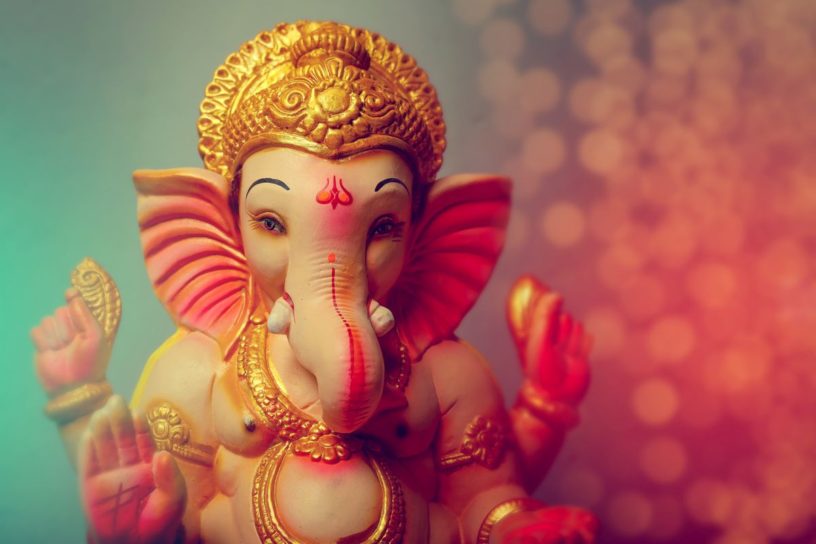From a discourse by the Paramacharya of SWAHA, Pt. Hardeo Persad
The concept of Ganesh must be seen in the context of the ultimate objective of Sanaatan Dharma. The first statement of the Ganesh Atharvashirsha, the Atharva Veda says, “Twameva Pratyaksham Tattvam Asi”: “O Gajaanand, You are the visible manifestation of Tattvam (Conscious Essence underlying all creation); Thou art That.”
The Vedas and the sages have said, “Yatha Pinde Tatha Brahmande”: “As in the microcosm, so in the macrocosm.” This is the state of non-duality, as expressed in the saying, “Aham Brahmasmi.” The ultimate state of realisation is that “I am One with God.” Ganesh Baba symbolises this state of non-duality. The elephant head represents the macrocosm; the human body the microcosm.
There are five mental afflictions that affect every one of us without exception: avidyaa (ignorance), asmitaa (ego), raag (attachment), dvesha (dislikes, aversions) and abhinivesh (fear of death). The latter four all stem from avidyaa, ignorance. The biggest obstacle we have in life is avidyaa, ignorance. Lord Ganesh is the Lord of Wisdom and the Remover of Obstacles. In order to remove avidyaa and gain gyaan (wisdom), we worship Lord Ganesh. All avidyaa stems from the notions of duality and plurality. This state of duality exists because we see subject and object: I hate this or I like that. I love this or I do not like that. These aversions and attractions, wants and needs, exist in this state of duality and plurality. To transcend this state, we must attain the concept of Ganesh, which is non-duality.
There are four qualifications necessary for liberation as stated in Vedanta. The first is vivek, which is discriminative power; a type of wisdom, it is the ability to differentiate between what is real and unreal, right and wrong. Bhagwat Mahaa Puraan tells us, there must also be bhakti (devotion), gyaan (wisdom) and vairaagya (detachment, dispassion). Worship Sri Gajaanand and achieve vivek, spiritual wisdom, which is the first pathway towards self realisation.
Shiv Puraan states that Sri Ganesh was created by Parvati Maa in order to guard her cave. From a yogic point of view, that cave is muladhar chakra (the subtle energy centre at the root of the spine). Shakti is kundalini (the divine energy coiled at the base of the spine in the unawakened state). Gajaanand Swami is yam and niyam, the forms of self restraint and positive virtues that we need to inculcate within ourselves before we can enter the cave of Mahaa Shakti, who is actually bhakti (devotion) personified. Shakti is Mumukshutva, that intense yearning to be one with God. The journey to self realisation begins with Gajaanand Swami. No one can achieve self realisation without going through Sri Ganesh.
We just celebrated Independence Day on August 31. Hinduism, since ancient times, has stated that moksha, liberation, is the supreme goal. Our true nature is independence. We are all striving towards that state. True independence is freedom from the cycle of duality and plurality, birth and death, metempsychosis or reincarnation. Ultimate independence, moksha, begins with the worship of Gajaanand Swami. This is not just ritualistic worship; we must change our attitudes from the inside.
Visarjan means immersion. At Ganesh Visarjan, Ganesh is immersed in the ocean. Aatma must be immersed in Paramaatma. When Gajaananand Swami is immersed in the ocean, we are trying to transcend duality and attain that ultimate state, Aham Brahmasmi, I am One with God. Gajaanand Swami is that universal, eternal Aatman present in every single one of us. If we worship Gajaanand Swami in ritual form, we must realise Him inside us. This journey can only begin with discriminative power, vivek.
Ramayan says: We perform our duties, our dharmas. From that we develop dispassion. Deep concentration leads to wisdom, the Ganesh principle. Then we are truly on the pathway to liberation. From the physical or external offering, bahya bhakti, we then move to ananya bhakti (exclusive worship of God in one’s heart) and, if we can reach it, ekanta bhakti, the purest form of devotion where the devotee loves God for His own sake. Here, we identify with Sri Ganeshji and attain that state of oneness, Aham Brahamasmi.



